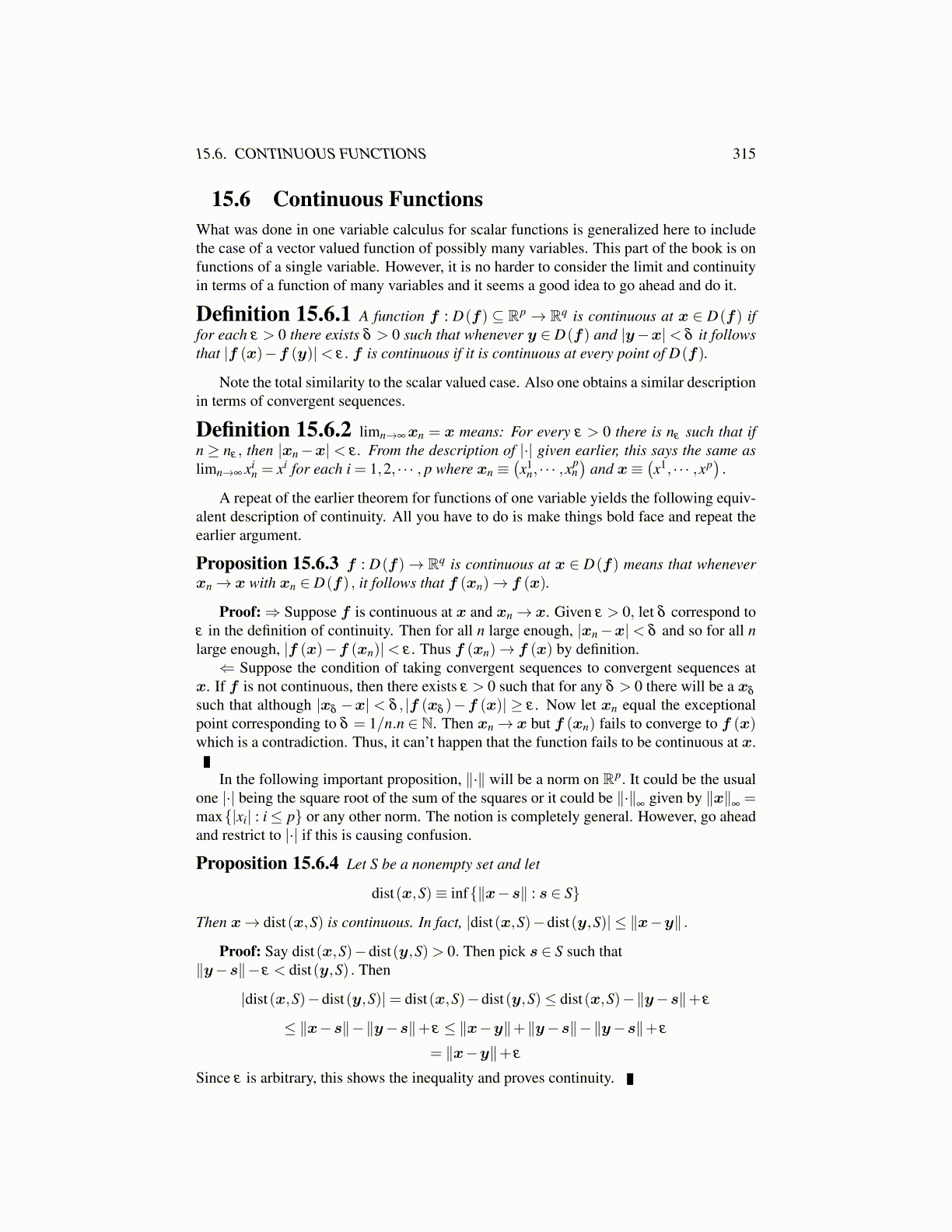
15.6. CONTINUOUS FUNCTIONS 315
15.6 Continuous FunctionsWhat was done in one variable calculus for scalar functions is generalized here to includethe case of a vector valued function of possibly many variables. This part of the book is onfunctions of a single variable. However, it is no harder to consider the limit and continuityin terms of a function of many variables and it seems a good idea to go ahead and do it.
Definition 15.6.1 A function f : D(f) ⊆ Rp → Rq is continuous at x ∈ D(f) iffor each ε > 0 there exists δ > 0 such that whenever y ∈ D(f) and |y−x|< δ it followsthat |f (x)−f (y)|< ε. f is continuous if it is continuous at every point of D(f).
Note the total similarity to the scalar valued case. Also one obtains a similar descriptionin terms of convergent sequences.
Definition 15.6.2 limn→∞xn = x means: For every ε > 0 there is nε such that ifn ≥ nε , then |xn −x| < ε . From the description of |·| given earlier, this says the same aslimn→∞ xi
n = xi for each i = 1,2, · · · , p where xn ≡(x1
n, · · · ,xpn)
and x≡(x1, · · · ,xp
).
A repeat of the earlier theorem for functions of one variable yields the following equiv-alent description of continuity. All you have to do is make things bold face and repeat theearlier argument.
Proposition 15.6.3 f : D(f) → Rq is continuous at x ∈ D(f) means that wheneverxn → x with xn ∈ D(f) , it follows that f (xn)→ f (x).
Proof: ⇒ Suppose f is continuous at x and xn → x. Given ε > 0, let δ correspond toε in the definition of continuity. Then for all n large enough, |xn −x|< δ and so for all nlarge enough, |f (x)−f (xn)|< ε . Thus f (xn)→ f (x) by definition.
⇐ Suppose the condition of taking convergent sequences to convergent sequences atx. If f is not continuous, then there exists ε > 0 such that for any δ > 0 there will be a xδ
such that although |xδ −x| < δ , |f (xδ )−f (x)| ≥ ε . Now let xn equal the exceptionalpoint corresponding to δ = 1/n.n ∈ N. Then xn → x but f (xn) fails to converge to f (x)which is a contradiction. Thus, it can’t happen that the function fails to be continuous at x.
In the following important proposition, ∥·∥ will be a norm on Rp. It could be the usualone |·| being the square root of the sum of the squares or it could be ∥·∥
∞given by ∥x∥
∞=
max{|xi| : i ≤ p} or any other norm. The notion is completely general. However, go aheadand restrict to |·| if this is causing confusion.
Proposition 15.6.4 Let S be a nonempty set and let
dist(x,S)≡ inf{∥x−s∥ : s ∈ S}
Then x→ dist(x,S) is continuous. In fact, |dist(x,S)−dist(y,S)| ≤ ∥x−y∥ .
Proof: Say dist(x,S)−dist(y,S)> 0. Then pick s ∈ S such that∥y−s∥− ε < dist(y,S) . Then
|dist(x,S)−dist(y,S)|= dist(x,S)−dist(y,S)≤ dist(x,S)−∥y−s∥+ ε
≤ ∥x−s∥−∥y−s∥+ ε ≤ ∥x−y∥+∥y−s∥−∥y−s∥+ ε
= ∥x−y∥+ ε
Since ε is arbitrary, this shows the inequality and proves continuity.